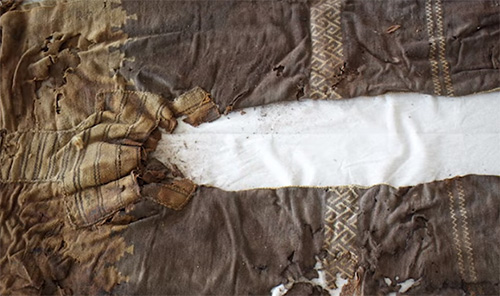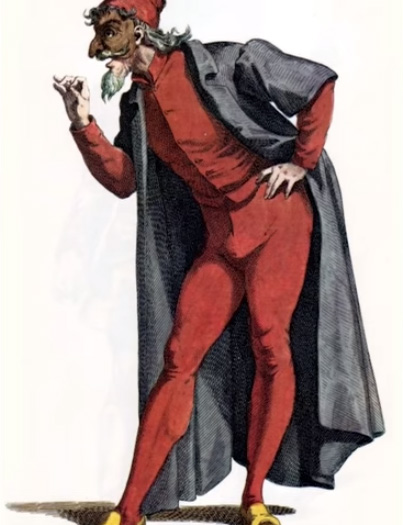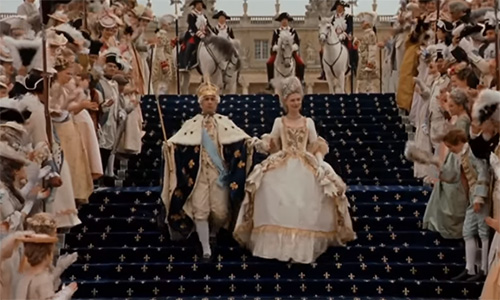 Today, pants or trousers is a must in any wardrobe, male or female. But it wasn’t always like that. For instance, 2-3,000 years ago, neither women nor even men wore pants in Ancient Greece and Ancient Rome. Moreover, trousers were banned. Later, Russian tsar Peter I forced his subjects to wear pants. And during the French Revolution people were hung for wearing one kind of trousers and not the other. Fortunately, these days, most people around the world are able to choose themselves if they want to wear pants and what kind of pants to use. But this article will help you to learn more about the trousers’ history and specifics.
Today, pants or trousers is a must in any wardrobe, male or female. But it wasn’t always like that. For instance, 2-3,000 years ago, neither women nor even men wore pants in Ancient Greece and Ancient Rome. Moreover, trousers were banned. Later, Russian tsar Peter I forced his subjects to wear pants. And during the French Revolution people were hung for wearing one kind of trousers and not the other. Fortunately, these days, most people around the world are able to choose themselves if they want to wear pants and what kind of pants to use. But this article will help you to learn more about the trousers’ history and specifics.
How did we as a culture get from wearing tunics, robes, gowns, and togas to cargo shorts and mom jeans? And why do we call them pants? So what was it that led to the invention of pants in the first place? Let’s find out what’s what.
When and why did pants first appear?
Tunic- and gown-wearing ancients must have had an overwhelming pile of cultural and practical reasons to abandon that breezy, free, flowing feeling, enjoyed still today by those who wear dresses, skirts, kilts, and bathrobes, in favor of wrapping each leg individually, right? Well, no, there was really only one reason for pants and that reason was horses.
As Science News explains, the oldest known pants come from Central Asia between 3,000 and 3,300 years ago, among nomadic herding cultures who found pants the best option for riding horses. The oldest pants so far discovered are from China's Tarim Basin, but pants were also worn by other nomadic equestrian cultures, like the Scythians about 2,500 years ago.
These early pants were straight-leg with a wide crotch, sewn together from wool cloth with slits on the side, a string fastener, and decorative weaving on the legs. Interestingly, the Tarim Basin pants seemed to have been woven to their final size with no cutting involved in their shaping.

The Ancient Greeks were not a pants-wearing people. They didn't like them. Instead, they tended to wear long flowing linen or wool garments that were belted or pinned in place. Men usually wore a linen tunic, over which they might wear a wool cloak in winter. Women wore tunics pinned at the shoulder. Greeks hated pants because, as The Vintage News explains, they thought they were ridiculous, but also because they associated them with foreigners. Pants were what Persians and other cultures wore; they were the clothes of barbarians, not of civilized Greek.
The Romans, of course, followed the Greek attitude on pants. The Latin word “braccatus”, which literally means “wearing pants”, was used to refer to people that Romans thought were foreign, barbarous, and – perhaps ironically, given our modern view of pants – effeminate. As Atlas Obscura points out, Roman hatred of pants was pretty much just straight-up nonsense, with the circular logic that pants were not sophisticated because sophisticated people don't wear pants.
However, by the time of the Early Empire, Roman soldiers were suddenly discovering that the swishy potato sacks with arm holes that worked so well in a Mediterranean climate, weren't up for the job of retaining territory in Germany, Switzerland, Britain, and elsewhere. Taking cues from their new Gaulish allies, Roman soldiers began wearing pants to protect their borders and their thighs from the Goths.
Before long, this military fashion caught on with civilians as well. And by 397 A.D., brothers and co-emperors Honorius and Arcadius issued a decree banning civilians from wearing pants in the capital.
In the end, though, bad news for the Romans meant good news for pants. The trousers ban ended when Alaric and his pants-wearing Visigoths army sacked Rome, more or less making the fall of the Western Empire in 476 inevitable.
In a complete 180 from the Roman pants ban, stands the mandatory pants reform of Peter I of Russia that is known as Peter the Great in the 17th century. Where for the Romans, pants were a symbol of barbarism and otherness that needed to be wiped out, for Peter, they were a sign of civilization and modernity that needed to be brought in at any cost.
When Peter became sole tsar of Russia in 1696, the country hadn't progressed much in about six centuries. The country was ruled by a tsar and a wealthy class of nobles called “boyars”, who, together with the crazy powerful orthodox church, maintained their wealth and power thanks to an enormous powerless serve class. The fashion of choice was long robes, long coats, and long beards.
However, Europe of this time was experiencing an explosion of progress in technology and trade and was soon knocking on Russia's door. Peter had been raised by a Western-educated mother and had himself traveled through enlightenment-era Europe in disguise and soaked in their culture. And he was determined to drag Russia, kicking and screaming, into the 18th century.
A major element of his modernization efforts was wardrobe reform, which meant robe-wearing boyars suddenly found themselves forced to wear pants and other Western-style outfits under penalty of a hefty fine, if they tried to enter Moscow. Peter's reforms met a lot of resistance, but pants won out in the end.
Etymology of words “pants” and “trousers”
You probably already know that the word “pants” is short for “pantaloons”. But what you might not know is that “pantaloons” is an anglicisation of the Italian word “pantalone”. Pantalone, in turn, was a character in a hugely popular Renaissance-era form of Italian comic theater.
As Merriam-Webster explains, Pantalone was a greedy, lecherous, scheming old man who often ended up being duped and humiliated and who could be recognized by his costume, which included a brimless hat, an open pleated black cassock, and long trousers.

When a similar style of pants became popular in the Restoration England, they named their new fashion after the comedy character, famous for his pants. Like how super short cutoff jeans would later be called “daisy dukes”.
While “pants” is the generic term for a garment worn from waist to ankles while covering each leg separately in American English, the preferred term for such a garment in British English is “trousers”. The word “trousers” can be traced back to a Gaelic word meaning “close-fitting shorts”, which, by the 1570s, could be found in English as “trews” and then “trousers” a decade later. They, probably, got added by the influence of “drawers” and other words described as a pair, like “tweezers” and “pliers”.
But even in American English, where it's not the generic term, trousers can be heard in certain contexts. Specifically, “trousers” is used to mean a tailored pair of pants with a waistband, belt loops, and a fly front.
Slacks, meanwhile, indicate less formal and tailored usually off-the-rack dress pants, which are often made of smooth wool knits which tend to hang slack.
Khakis are dress casual pants, usually light tan in color.
Chinos are flat-front dress pants, often light beige in color.
And then, there are jeans – hopefully, you know what those are.
Pants variations
Before the full-length open-leg trousers we know today became the default form of pants, European pants took multiple different forms. Namely, these are breeches, pantaloons, and knickerbockers. Prior to the late 16th century, the main term for leg coverings was “hose”, which were, generally, separate coverings for each leg joined by a codpiece.
But these were replaced by breeches, which were a single, sewn together garment. Breeches usually ended right below the knee or midway down the calf with either boots or stockings worn below if a gentleman wanted to show off some of his sexy leg-day games. Breaches fell out of fashion by 1820 and were replaced by pantaloons, which were slimmer-fitting and reached down to the ankle.
By the 1840s, looser-fitting trousers replaced the tight pantaloons, inspired by sailors who popularized the look. But knee-length pants saw a resurgence in popularity in the 20th century in the form of knickerbockers, which are baggy knee-pants that end at or just below the knee. These were popular for young boys in the early 20th century and remain popular today for sports uniforms.
Never has the difference between two styles of pants been bloodier or more political than during the French Revolution. The militant radical partisans of the lower-class common people of France during the French Revolution and reign of terror were known as “sans-culottes”, meaning “without breeches”. This might make you picture a much sexier revolution than actually occurred, until you realize that no breeches doesn't mean they didn't wear any pants, just that they didn't wear a specific kind of pants.

Culottes in this instance refer to knee-length silk breeches, favored by the aristocracy, against whom the rebels were rebelling. The working-class radicals, who had come to be known as the sans-culottes, wore ankle-length pantaloons or trousers. The sans-culottes were the radicals who called for the executions without trial that led to the reign of terror.
Still, the association between knee-breeches and aristocracy stuck, which caused them to fall out of fashion in the 1800s.
Women and pants
Pants, of course, have for most of history been considered men's clothing. But in the early 1850s, a women's rights advocate named Amelia Bloomer suggested as rational dress for women a costume made up of a short jacket and a knee-length skirt, under which would be worn loose ankle-length trousers. While the full costume didn't last, loose-fitting women's trousers – once very popular for women to wear while bicycling – and, of course, women's baggy underwear would continue to bear the name “bloomers” after their most prominent advocate.
The fight to make pants a gender-neutral garment in Europe and America has been a long one. It was technically illegal for women to wear pantalone in Paris thanks to the violent reputation of the sans-culottes.
In the 19th and early 20th centuries, pants became a more common accessory for some working women, including coal mine workers known as “pit brow lasses” and pilots. Designers started making pants for women and they began being considered leisurewear, but women wearing pants in public could still cause a scandal, as happened with actress Katharine Hepburn.
Fortunately, World War II helped to normalize the idea of women wearing pants thanks to them becoming common for women working in factories during that time. Even though the progress has not been quick or steady or even unidirectional, it has become much more than norm for it to be cool for women to wear pants when they want to.
(c)



by these.
tunics and gowns to trousers